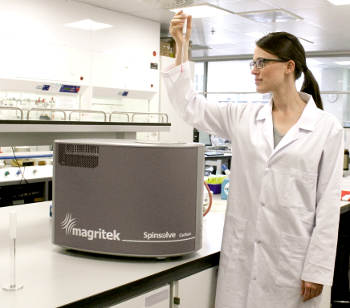Magritek, a leading provider of compact NMR and MRI instruments, is pleased to announce the Spinsolve Carbon. For organic chemists, carbon-13 (13C) NMR forms the backbone of routine molecular analysis. For the first time users can have the power of a 1D and 2D proton-carbon NMR in a benchtop instrument that can be safely used in the laboratory.
The launch of Spinsolve Carbon follows naturally after the successful adoption of the Spinsolve family of benchtop NMR spectrometers by users around the globe. It has been designed to meet the needs of specific groups of users. These are split into several categories: pharmaceutical and medicinal chemists, synthetic chemists, academics focused on organic chemistry education and researchers working on the structure elucidation of organic molecules.
 The Magritek Spinsolve Carbon benchtop NMR spectrometer
The Magritek Spinsolve Carbon benchtop NMR spectrometer
To meet the requirements of these users, Magritek have produced a comprehensive list of features designed to deliver cost efficient benefits to all. Spinsolve Carbon offers users 1D 1H, 19F and 13C experiments that use standard 5 mm NMR tubes. 13C experiments include spectral editing with DEPT, 2D direct HETCOR experiment and 2D indirect experiments such as HMQC and HMBC. For proton 2D COSY and homonuclear j-resolved spectroscopy are offered along with T1 and T2 relaxation experiments,
Users of Spinsolve systems have found them to be particularly convenient and robust to use. They have low running costs as no cryogens are required and are virtually maintenance-free. In laboratories where time to getting results is imperative, ease of operation makes it perfect for students and chemists who want immediate results. Not having to send samples away for analysis is a great bonus particularly to keep students interested in learning a new technique as part of a practical course.
13C NMR Spectroscopy delivers more detail in its spectra than use of the more basic 1H nucleus. Carbon has a large chemical shift range of approximately 250 ppm and using composite pulse decoupling there is usually a single peak per carbon atom in the molecule making carbon spectra much more informative than proton spectra. Furthermore, multinuclear and multidimensional experiments reveal additional structural information such as how carbon and proton atoms in the molecule are connected. This enables NMR to easily resolve isomers that are often confused with other analytical methods.
Intuitive software aids to the simplicity of Spinsolve Carbon. Simple, one-button operation with minimal user controlled parameters coupled to an intuitive graphical interface makes the system easy to operate by anyone from students to research chemists. For reaction monitoring applications the system may be automated and integrates closely with the industry leading MNova data processing software from Mestrelab. The traditional NMR complexities are hidden and automated which make using a Spinsolve a quick learning experience while delivering research-grade results.
You can obtain full details of Spinsolve Carbon benchtop NMR spectrometer and the full range of analytical products from Magritek by visiting, www.magritek.com where a PDF of the 13C brochure is also available for download.
About Magritek
Magritek provides complete NMR and MRI solutions and applications for Chemical, Pharmaceutical, Oil and Gas, Food and Construction Industries as well as components and subsystems suitable for Research Laboratories and Academic Education. Magritek has offices in Aachen, Germany, San Diego, USA, and Wellington, New Zealand and a global network of distributors and agents to support customers. The initial NMR technology and IP used in Magritek products grew out of decades of world-class research by Ampere prize winner Professor Bernhard Bluemich's group at RWTH Aachen University, and Gunther Laukien prize winner Paul Callaghan's team at Massey University and Victoria University of Wellington.
For details on Magritek and all its products & solutions, visit www.magritek.com.